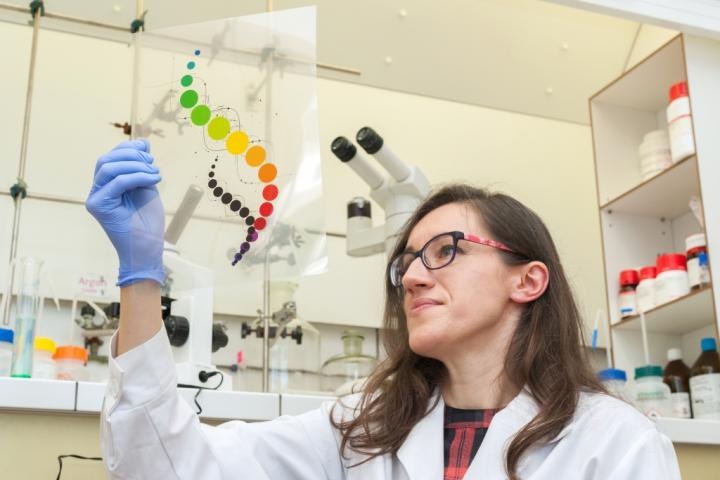Nov 1 2018
Chemists from Warsaw, Denton, and Milan have demonstrated that a fragment of a single strand of DNA, made up of the nucleobases cytosine and guanine, can be imprinted in a polymer. The subsequent artificial negative, with a record-long length, works chemically like a regular strand of deoxyribonucleic acid. This accomplishment finally confirms the likelihood of developing polymer imprints of DNA, functionally corresponding to DNA fragments encompassing all four nucleobases.
 At the Institute of Physical Chemistry of the Polish Academy of Sciences in Warsaw a record-long fragment of DNA was imprinted in the polymer. (Image credit: IPC PAS, Grzegorz Krzyzewski)
At the Institute of Physical Chemistry of the Polish Academy of Sciences in Warsaw a record-long fragment of DNA was imprinted in the polymer. (Image credit: IPC PAS, Grzegorz Krzyzewski)
A chemical DNA negative using molecular imprinting was developed a year and a half ago by a Polish-American-Italian team of researchers. Molecular cavities, produced in a meticulously designed polymer, acted chemically just like a real DNA strand (matching to the one used for imprinting). The first oligomer “imprinted” in the polymer was short, comprising of only six adenine and thymine nucleobases forming the TATAAA sequence. Recently, a team from the Institute of Physical Chemistry of the Polish Academy of Sciences (IPC PAS) in Warsaw, headed by Professor Wlodzimierz Kutner and cooperating with the University of North Texas in Denton (USA) and the University of Milan (Italy), has taken the subsequent step. In the journal ACS Applied Materials & Interfaces, the scientists have illustrated the process of developing a negative fragment of a single strand of DNA comprising of the other nucleobases: guanine and cytosine.
“The oligonucleotide now imprinted in the polymer is slightly longer than that described in our previous publication. However, this was not about breaking records. Most importantly, it was to show that the molecular imprinting method can be used to build stable negatives of oligonucleotides containing all of the nucleobases in deoxyribonucleic acid,” says Prof. Kutner.
Each DNA molecule is a ribbon twisted into a helix, composed of two long, permanently connected strands. A single strand includes nucleotides with numerous repetitions, each of which contains one of the nucleobases: adenine (A), guanine (G), cytosine (C), or thymine (T). Since the adenine existing on one strand is corresponding to thymine on the other, and guanine to cytosine, on the basis of a single strand of DNA, it is simple to rebuild its complementary partner. This mechanism not only increases the durability of the record of the genetic code, but also permits it to be transcribed from DNA to RNA in the process of transcription, which is the primary stage of protein synthesis.
“DNA molecules are very long; if they were to be straightened out, they would have a length measured in centimetres. Under normal conditions, the double-stranded DNA is, however, twisted and coiled in various ways. The imprinting of such a spatially complicated structure in the polymer is not only impossible, but also does not make sense, because different molecules of the same DNA can be twisted in different ways. Therefore, as a rule, during double-stranded DNA testing, its strands are first separated, and then cut into fragments containing from several to several dozen nucleotides. It is then possible to attempt to imprint these fragments of this length in the polymer,” explains Dr Agnieszka Pietrzyk-Le (IPC PAS).
So as to imprint the molecules in the polymer, they are added into a solution of monomers, or “building blocks,” from which, next, the future polymer is to be developed. A few of the monomers are chosen so as to self-assemble themselves around the molecules being imprinted. The combination is then electrochemically polymerized. This electropolymerization forms a thin, hardened film of a polymer, from which the imprinted molecules are then extracted. In this manner, a polymer is acquired with molecular cavities corresponding to the original molecules not only in shape and size, but even their local chemical properties.
“In our latest research, we have shown that it is possible to imprint into the polymer the GCGGCGGC oligonucleotide, i.e. one that contains eight nucleobases. This oligomer is genetically significant. Its presence, among others, increases the probability of neurodegenerative diseases,” explains PhD student Katarzyna Bartold (IPC PAS).
The initial polymer negative, having an imprinted adenine-thymine oligomer, was entirely selective, that is only the TATAAA molecules formerly used to prepare the polymer could enter the molecular cavities. In the presently synthesized polymer, the guanine-cytosine cavities are also extremely selective, but this selectivity is still unsatisfactory. If the oligonucleotide captured from the solution varies only by one base from the GCGGCGGC oligonucleotide used for imprinting, the cavity may not consider this difference. Scientists attribute this behavior to bonds between cytosine and guanine stronger than those between thymine and adenine.
“Interestingly, in some respects our DNA negative appears to have better properties than those of the natural DNA strand. The true DNA strand has nucleotide cores that are electrically negatively charged, which makes the molecules repel each other in solution. Chemists must, therefore, neutralize this charge by, for example, introducing positive sodium ions. Our molecular cavities are already electrically neutral. Therefore, using our polymer DNA analogue, we eliminate one stage of the research: neutralization,” observes Dr Pietrzyk-Le.
Going forward, the scientists are keen to improve the developed method, imprinting ever longer fragments of DNA, so that oligonucleotides comprising of at least a dozen or so nucleotides can be mapped. Polymer films with such long molecular cavities would enable building effective detectors of genetically vital DNA fragments. This would be viable since the mass of the polymer with cavities filled with oligomers trapped from the test solution increases, the electrical conductivity of the polymer also varies, and changes in these parameters can be easily noticed. In the future, there is a possibility for another application as well. Polymer films with imprinted DNA fragments and molecular cavities packed with these fragments can be used to examine new drugs targeted at genetic diseases.